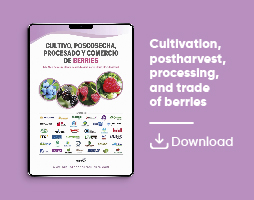Actualidad
Postharvest practices of peppers in Israel ? 15 years of research
Sweet pepper is the second largest export commodity in Israel, with approx. 140,000 tons of fruits from several types (bell, elongated and chili) marketed mostly in Europe, some being sold in North America. This necessitates the practice of excellent pre- and postharvest techniques which will maintain fruit quality for more than 2 weeks. We have conducted both basic and applied research during the last 15 years to develop and improve postharvest practices for Israeli-grown peppers. Fruit should be harvested during the cool hours of the day using sharp and clean knives or clippers, with or without the calyx (stem), at 80-85% final color. The harvesting team must wear gloves. Fruits are placed inside prewashed
02 March, 2021
Redaccion
Sweet pepper is the second largest export commodity in Israel, with approx. 140,000 tons of fruits from several types (bell, elongated and chili) marketed mostly in Europe, some being sold in North America. This necessitates the practice of excellent pre- and postharvest techniques which will maintain fruit quality for more than 2 weeks. We have conducted both basic and applied research during the last 15 years to develop and improve postharvest practices for Israeli-grown peppers. Fruit should be harvested during the cool hours of the day using sharp and clean knives or clippers, with or without the calyx (stem), at 80-85% final color. The harvesting team must wear gloves. Fruits are placed inside prewashed plastic crates lined with foam padding to prevent mechanical injury to the produce. Harvesting crates must not be overfilled in order to prevent crushing when crates are stacked one on another. Harvest crates must not come into contact with soil. Harvested produce must be transported on harvest carts as soon as possible to the pack house while the load is protected from direct sun or rain with shade net or water-proof screen. Harvested produce must be kept cool, shaded and well ventilated. The washing, grading and sorting machines must be thoroughly cleaned daily before or after work. Fruit are washed in hot water (55?C) supplemented with a disinfectant compound for about 15 s as they roll over spinning brushes (HWRB machine, ?Hot Water Rinsing and Brushing? machine). After the hot water wash, fruit are dried by forced-air dryers prior to electronic sorting and grading. Only high quality fruit are packed in bulk in a corrugated new carton, plastic crates, or perforated plastic bags or sleeves, depending upon the export market. Cartons are palletized and as soon as possible should be transferred to the precooling transit station at 7?C and 93-95% RH for 12 to 24 hours, until they are brought to the export terminals in a refrigerated (7?C) disinfected truck or container. At the port, the fruit quality is inspected again by government agricultural agents and the pallets are kept at 7?C and 95% RH until they are loaded on a refrigerated ship or containers at 7?C and 93-95% RH for export. In order to maintain fruit quality during the whole year, especially during the hot Israeli summer, special pre-harvest practices have also been developed. Growing peppers under colored shade nets, especially in shades of pearl and yellow, maintains better fruit quality after harvest. Those nets also reduced insect infestations and increased yield. The presence in Israel of the Mediterranean fruit fly (Medfly) prevents export of peppers to quarantine countries like Japan. Exposure to cold air is a well known treatment for killing Medfly on fresh produce. However, keeping pepper fruit at temperatures below 7?C for several days can cause severe chilling injury (CI). We have found that a combination of HWRB and Xtend? plastic bag packaging can significantly reduce incidence of CI after 3 weeks storage at 1.5?C. This treatment also killed Medfly eggs and larvae in infected fruit.?? ACCESS to the complete text Pictures1 - Cover page2 - Recommended maturity stage for harvesting bell sweet pepper (80-85% in color)3 - Greefa, specialist in pepper selection and grading4 - CEBE, solutions for sanitation in field and postharvest Key wordsPoscosecha?? ?postcosecha?? ?postharvest?? ?na-oes?? ??? ??? ???????? ????? ??? ?post-r?colte?? ????? ?? ??????????? ??? ?na-oogst?? ?post-raccolta?? ?Obr?bka po?? ?p?s-colheita?? ????????????????? ?hasat sonras??? ??? ?Ernte?? ????????????????? ????? ????????????? ?postcollita?? ?poskliz?ov頠 ????? ??? ??? ??? ?nakon branja?? ?pozberov頠 ??? ?obdelovanje zemlje po?? ?post-colleita?? ?????? ??????? ?pascapanen?? ??il?onn postharvest?? ??????? ?p?c ra?as?? ?derliaus apdirbimas po?? ?lepas tuai?? ??? ?? ???????? ?post-recoltare?? ??????? ??????? ???????????????????? ?????????????? ?????????????????? ?sau thu ho?ch?? ?????????????????? ?zangemva kwenkathi yokuvuna?? ??? ?Pimiento?? ?morr?n?? ?pepper?? ?peper?? ??????? ????? ?pipro?? ?poivre?? ????????? ????? ??????? ??? ?pepe?? ?pieprz?? ?pimenta?? ???????? ?biber?? ????? ??????








